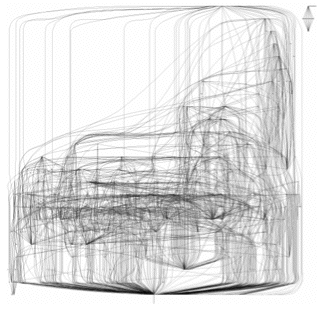TITLE: Computation and Art
AUTHOR: Eugene Wallingford
DATE: December 30, 2004 8:06 AM
DESC: Computing isn't about programs. It's a medium for expression that opens new avenues to us all.
-----
BODY:
For your daily reminder of what computation can do
and the future of art might be like, check out
Jared Tarbell's
Gallery of Computation.
The artwork generated by Tarbell's code is complex
yet often quite alluring. So many artists use
computation as medium these days that this site is
"nothing new", but I was struck by the beauty of the
images produced.
I was also struck by the fact that all of the code for
producing these works is available on-line:
I believe all code is dead unless executing within the
computer. For this reason I distribute the source code of
my programs in modifiable form to encourage life and spread
love. Opening one's code is a beneficial practice for both
the programmer and the community. I appreciate modifications
and extensions of these algorithms. Please send me your
experiences.
Eugene sez: Two thumbs up!
I've had one student do work of this sort. A few years
ago, I had a student named David Schmudde. Dave is one
of those guys who mixes both technical skills and interests
with artistic skills and interests, both music and visual
art. For his course project in Intelligent Systems, he
created a program called Ardis. This program acts like a
set of sophisticated Adobe Photoshop filters. It consists
of a set of rules about the features of paintings done in
certain artistic styles, such as German Expressionism.
Given an image of any sort, it applies the rules of the styles
selected by the user to the images in funky ways, as if to
say "How would a German expressionist have made this picture?"
In the case of German Expressionism, it finds lines that
mark objects and exaggerates them. The program uses a bit
of randomness in its filtering, which means that you can use
Ardis to create a set of images all of a theme.
As his instructor, I was most impressed that Dave wrote almost
all of the code that makes up Ardis. At the time, there wasn't
all that much in the way of image processing packages in Java,
so he went off and learned what he needed to implement and did
it himself. The program isn't perfect or polished, not nearly
as much so as Tarbell's work on-line, but it was a great result
for a semester's work. Dave went on to do a master's degree in
music and technology at Northwestern, which he just completed
last spring. I'll have to dig out Ardis and see if I can't
package it up for folks to play with and extend.
[ Update: I found an old pointer to a description
of Ardis on line. Check out David's page
http://www.davidshino.com/ardis.html
for a bit about his program. ]
 Sometimes, a computer scientist can produce a beautiful picture
without intending to. One of my current M.S. students, Nathan
Labelle, is working on a project involving power laws and
open-source software. In the course of displaying a particular
relationship among 100 randomly selected Linux packages, he
produced the image to the right: a graph that appears to be
a wonderful line drawing of a book whose pages are being riffled.
I think it's quite beautiful.
-----
Sometimes, a computer scientist can produce a beautiful picture
without intending to. One of my current M.S. students, Nathan
Labelle, is working on a project involving power laws and
open-source software. In the course of displaying a particular
relationship among 100 randomly selected Linux packages, he
produced the image to the right: a graph that appears to be
a wonderful line drawing of a book whose pages are being riffled.
I think it's quite beautiful.
-----
 Sometimes, a computer scientist can produce a beautiful picture
without intending to. One of my current M.S. students, Nathan
Labelle, is working on a project involving power laws and
open-source software. In the course of displaying a particular
relationship among 100 randomly selected Linux packages, he
produced the image to the right: a graph that appears to be
a wonderful line drawing of a book whose pages are being riffled.
I think it's quite beautiful.
-----
Sometimes, a computer scientist can produce a beautiful picture
without intending to. One of my current M.S. students, Nathan
Labelle, is working on a project involving power laws and
open-source software. In the course of displaying a particular
relationship among 100 randomly selected Linux packages, he
produced the image to the right: a graph that appears to be
a wonderful line drawing of a book whose pages are being riffled.
I think it's quite beautiful.
-----